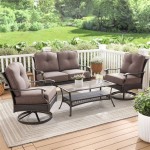Best Patio Heaters: A Comprehensive Guide to Outdoor Comfort
As the days grow shorter and temperatures begin to dip, extending the usability of outdoor spaces becomes a priority for homeowners and businesses alike. Patio heaters offer a practical solution, providing warmth and ambiance to decks, patios, and other outdoor areas. Choosing the best patio heater, however, requires careful consideration of various factors, including fuel type, heating capacity, coverage area, safety features, and overall cost.
This article will explore the diverse world of patio heaters, offering a comprehensive overview of the different types available, the key features to consider, and insights into making an informed purchase decision. Understanding these elements will enable consumers to select the optimal heating solution for their specific needs and maximize their enjoyment of outdoor spaces throughout the colder months.
Fuel Types: Propane, Natural Gas, and Electric
Patio heaters primarily utilize three fuel types: propane, natural gas, and electricity. Each option presents distinct advantages and disadvantages in terms of cost, convenience, and performance. Understanding these differences is crucial in determining the most suitable fuel source for a given application.
Propane Patio Heaters: These are perhaps the most common type, recognized for their portability and ease of use. Propane heaters typically involve a self-contained unit that houses a propane tank, making them readily movable and adaptable to different locations within a patio or outdoor area. They generally offer high heat output, providing ample warmth for larger spaces. However, the need to regularly refill or exchange propane tanks represents an ongoing cost and potential inconvenience. The cost of propane fuel can also fluctuate, impacting the overall operating expense.
Natural Gas Patio Heaters: Natural gas heaters offer a more permanent and potentially cost-effective solution. These units connect directly to a natural gas line, eliminating the need for tank refills and ensuring a continuous fuel supply. This makes them ideal for frequently used outdoor spaces where convenience is paramount. However, installation requires professional plumbing to connect to the gas line, adding to the initial cost. Furthermore, natural gas heaters are less portable than propane models, limiting their relocation options once installed.
Electric Patio Heaters: Electric patio heaters, including infrared and quartz models, present a clean and efficient heating alternative. They operate by converting electrical energy into heat, eliminating the need for combustion and producing no emissions. Electric heaters are typically easy to install, requiring only access to a standard electrical outlet. They also tend to be quieter in operation compared to gas-powered models. However, electric heaters often have lower heat output compared to propane or natural gas options, making them better suited for smaller, more enclosed spaces. Moreover, electricity costs can vary significantly, potentially impacting the long-term operating expenses.
Key Features and Considerations
Beyond the fuel type, several key features significantly influence the performance, safety, and overall satisfaction with a patio heater. These include heating capacity, coverage area, safety features, and design aesthetics. Evaluating these aspects ensures the selected heater effectively meets the specific requirements of the outdoor space.
Heating Capacity and Coverage Area: The heating capacity of a patio heater is measured in British Thermal Units (BTUs). A higher BTU rating generally indicates a greater heat output, capable of warming a larger area. Determining the appropriate BTU rating depends on the size of the patio or outdoor space, the ambient temperature, and the desired level of warmth. For smaller patios or enclosed spaces, lower BTU heaters may suffice, while larger, more open areas may require higher BTU models to provide adequate warmth. Manufacturers typically provide guidelines on the recommended coverage area for each heater, which should be carefully considered during the selection process.
Safety Features: Safety is paramount when operating any heating appliance, particularly in outdoor environments where factors like wind and weather can impact stability and performance. Essential safety features to look for include tip-over shut-off mechanisms, which automatically turn off the heater if it is accidentally knocked over, preventing potential fire hazards. Overheat protection is another crucial safety feature, designed to shut down the heater if it exceeds a safe operating temperature. Some models also incorporate flame failure devices, which cut off the gas supply if the flame is extinguished, preventing gas leaks. Furthermore, consider models with stable bases and durable construction to minimize the risk of accidental tipping.
Design and Aesthetics: Patio heaters are available in a wide range of styles and designs, from traditional mushroom-style heaters to sleek, modern models. The aesthetic appeal of the heater should complement the overall design of the patio or outdoor space. Consider factors such as the color, finish, and overall shape of the heater to ensure it integrates seamlessly with the existing décor. Tabletop heaters offer a compact and stylish option for smaller spaces, while standing heaters provide a more substantial presence and can serve as a design focal point. Wall-mounted heaters are ideal for maximizing space and creating a clean, uncluttered look.
Material and Durability: The durability of a patio heater is directly related to the materials used in its construction. Stainless steel and powder-coated aluminum are common choices, offering excellent resistance to rust, corrosion, and weather damage. These materials are particularly important for heaters that will be exposed to the elements year-round. Consider the thickness and quality of the materials used, as well as the overall construction of the heater, to ensure it can withstand the rigors of outdoor use.
Specific Types of Patio Heaters and Their Applications
The market offers a variety of patio heater designs tailored for specific applications and preferences. Understanding these variations helps in selecting the most suitable type for a particular setting.
Mushroom Patio Heaters: This is the classic and most recognizable type, characterized by its tall, mushroom-shaped reflector that directs heat downwards. They are typically powered by propane and are suitable for larger patios and outdoor areas. Their height allows for even heat distribution over a relatively wide area.
Tabletop Patio Heaters: These are compact and portable heaters designed to sit on a table, providing localized warmth for smaller groups. They are often powered by propane or electricity and are ideal for intimate gatherings or smaller outdoor spaces.
Wall-Mounted Patio Heaters: These heaters are mounted directly to a wall, saving valuable floor space and providing a sleek, modern look. They are typically powered by electricity and are well-suited for balconies, covered patios, and other areas where floor space is limited.
Hanging Patio Heaters: Similar to wall-mounted heaters, hanging heaters suspend from a ceiling or overhead structure, providing warmth from above. They are typically powered by electricity and are ideal for covered patios, gazebos, and other outdoor spaces with overhead support.
Infrared Patio Heaters: These heaters use infrared radiation to directly heat objects and people, rather than heating the air. They are highly efficient and provide instant warmth, making them ideal for colder climates. Infrared heaters can be powered by electricity, propane, or natural gas.
Quartz Patio Heaters: A type of electric infrared heater that uses a quartz lamp to generate heat. They are known for their quick heat-up time and efficient energy consumption. Quartz heaters are suitable for smaller, enclosed spaces.
Beyond these broad categories, various niche types exist, such as fire pit tables, which combine the warmth of a fire pit with the functionality of a table, and portable radiant heaters, offering targeted heat for specific areas. The choice Ultimately depends on the space, budget, and personal preferences.
When considering a patio heater purchase, evaluating the features discussed will aid in finding the optimal balance between cost, performance, safety, and aesthetics. Prioritizing these elements will contribute to extending the enjoyment of outdoor spaces during colder seasons.

The 2 Best Outdoor Patio Heaters Of 2024 Reviews By Wirecutter

10 Best Patio Heaters And Outdoor In 2024

The 2 Best Outdoor Patio Heaters Of 2024 Reviews By Wirecutter

The 2 Best Outdoor Patio Heaters Of 2024 Reviews By Wirecutter

Best Patio Heaters To Buy In The For 2024

2024 S Best Patio Heaters For Your Garden Outdoor Living Space

The 2 Best Outdoor Patio Heaters Of 2024 Reviews By Wirecutter
2 Best Outdoor Patio Heaters Of 2024

12 Best Outdoor Heaters 2024 The Strategist

7 Best Outdoor Heaters Ourquadcities
Related Posts








